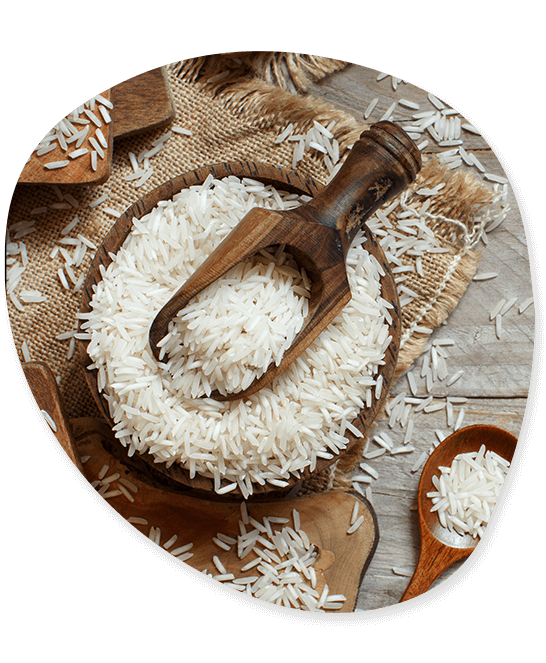Rice
One of the most well-liked and widely consumed staple foods is rice. It has the third-highest global production of any agricultural product and is widely consumed in Asia and Africa. Although it can live as a perennial crop in climates like the tropics, it is often produced as an annual plant.

Nutrients: 1 cup per 186gms
Minerals:
Vitamins:
- Vitamin B
Pre-Shipment Inspection:
Standard Packing:
RICE VARIETIES WE EXPORT
One of the types of rice that is frequently found in India is basmati. It has a wonderful aroma and is renowned for its grain that appears long and slender. Because of its distinct flavour, basmati rice is appreciated all over the world. It works best in recipes like pilaf, fried rice, biryani, and other well-known cuisines. India is one of the top exporters of basmati rice.

1121 BASMATI RICE – WHITE
The Basmati rice variety Pusa Basmati 1121 inherits qualities from more established Basmati cultivars like Type 3 and Basmati 370. This variety essentially evolved through the hybridization process. Beginning in 2003, 1121 Basmati rice was grown commercially. It has extra-long, slender milled grains, a nice aroma, volume expansion that exceeds four times, a delectable taste, a pleasant texture, and is simple to digest.

TRADITIONAL BASMATI RICE
Different varieties of basmati rice exist. Basmati 370, Basmati 385, and Basmati Ranbirsinghpura are examples of traditional varieties. There are two types of traditional basmati rice: raw and parboiled. It is utilised in Chinese, Mughlai, Indian, and Continental cuisines.

GOLDEN SELLA BASMATI RICE
More vitamins and minerals from the original grain are retained when rice is parboiled. The process ensures that the grain will cook up solid. Rice that has been parboiled is devoid of gluten and cholesterol. Both salt and saturated fat levels are modest. Complex carbohydrates included in rice are available for the body to utilise as fuel.

SUGANDHA BASMATI RICE
One of India’s most affordable brands of long grain basmati rice is called Sugandha. It is typically grown in states like Punjab, Haryana, Uttar Pradesh, and others in India. Sugandha Basmati Rice is non-sticky and has a wonderful aroma. In comparison to 1509 Basmati and 1121 Basmati rice, it is often a little shorter. If it is cooked properly, it may grow up to twice as long.

SHARBATI BASMATI RICE
Because it is a hybrid of traditional basmati rice, sharbati basmati rice lacks a distinctive aroma. Sharbati Basmati Rice can be prepared similarly to Basmati Rice. It is 14 to 15 MM length. The rice grain is roughly 7.1–7.2 MM long.
NON-BASMATI RICE
Non-basmati rice is any other type of rice outside basmati. Rice that isn’t basmati includes all types, shapes, and sizes of rice. Some varieties of rice are short and thick, while others are long and slender. Non-Basmati rice is consumed regularly in households and is also exported for business purposes.

PARBOILED RICE
Parboiled rice has been partially boiled while still in its husk. It is similar to how simple it is to prepare rice. To parboil something, you must first soak, steam, and then dry it. These procedures make it simpler to handle the rice by hand. Additionally, parboiling improves the nutritional value of the food while altering the texture and increasing weevil resistance.

BROKEN RICE
First off, despite the name “broken rice,” there is nothing wrong with this particular variety. Like all rice, it is equally nutrient-dense. Basically, it is only broken rice grains from the field, drying, shipping, or milling. The broken grains are separated from the entire grains and sorted according to size using mechanical separators.

SWARNA RICE
One of the healthiest rice options is swara. Due to its low glycemic index, it has a very minimal risk of developing diabetes. In India, swara rice is widely farmed.

SONA MASOORI RICE
Sona masuri rice is a medium-grain variety that is mostly grown in the Indian states of Andhra Pradesh, Telangana, and Karnataka. Sona Masuri means “Golden Ivy” in English. It is fragrant and light. Major markets for this expensive species of rice include the United States, Canada, Europe, Malaysia, and nations in the Middle East like Saudi Arabia and Qatar.
